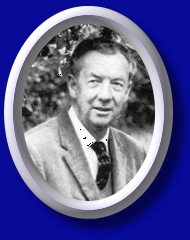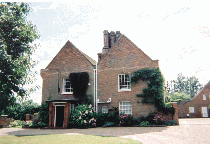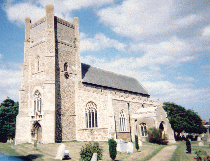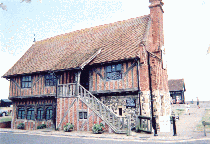
Music Director David Key writes about his recent visit to Aldeburgh |
My final stop of the Suffolk visit was to Orford, and in particular Orford Church. This was the setting for the world premieres of Noye's Fludde (1958), Curlew River (1964), The Burning Fiery Furnace (1966) and The Prodigal Son (1968). A rather ordinary church in the main, but its large congregational area proved quite suitable for these works to be performed. |
My next visit was to a much expanded concert venue 6 miles from Aldeburgh. The Snape Maltings Concert Hall is set in the stunning marshland next to the River Alde and is also home to the Britten-Pears School for Advanced Musical Study. The concert hall serves a vibrant musical calendar for most of the year, not just for the unique Aldeburgh Festival each June. The Concert hall was also home to many recording ventures for Britten later in his life. |
My next stop was to Crag House in the center of Aldeburgh and was home to Britten and Pears from 1947-57. It is a rather quaint little house set on the Aldeburgh seafront. A walk further along the seafront took me to the Moot Hall, a very attractive and characteristic landmark, and served as a social hub in act III of Britten's monumental Peter Grimes of 1945. My final visit in the Aldeburgh seafront was to the famous Jubilee Hall, a unique and very important concert venue for early Aldeburgh Festivals and other concert gatherings in the early-mid twentieth century. |
A visit to Aldeburgh was certainly going to involve hunting down the major Britten landmarks, and my next visit was to the Church of St Peter on the outskirts of Aldeburgh, not only an important concert/recording venue during Britten's lifetime, but it's also the resting place for Britten, Pears and his devoted amanuensis of the 50's/60's Imogen Holst. |
Whilst visiting the Library, I was able to meet the Library Director and Britten scholar, Jenny Doctor who very kindly gave me a tour of the collection. Other Britten scholars I met included Judith LeGrove and Paul Kildea, who both work at the Library, as well as maintaining other outside research commitments. It was truly a memorable and positive experience viewing this fascinating collection and I am very grateful for the kind hospitality of the staff at the library during my visit there. |
My first place of visit in Suffolk was the Britten-Pears Library which is housed in the wonderful grounds of the Red House. The Britten-Pears Library is governed by the Britten-Pears Foundation and is an international research centre for all studies relating to Benjamin Britten. Originally assembled by Benjamin Britten and Peter Pears, the Library is a working collection of manuscripts, books, music and sound recordings and has been developed to further include literary materials, photographs and special collections. It was most intriguing to view the whole collection upon my recent visit and it's very touching and assuring to see that the library has preserved its heritage ever since it's beginnings in the 1960's. |
My return to the UK in August was full of much excitement and anticipation not only about the prospect of returning to my native homeland, but also visiting a place that I'd read a lot about, saw many pictures of and had many discussions about. This was Aldeburgh and home of Benjamin Britten for most of his life. |
My visit to Suffolk this past summer was a most enjoyable and memorable one, not only because the sun was shinning in this delightful part of East Anglia, but more importantly because many areas was where Britten lived and worked for the greater part of his life. Such an aura was at times an overwhelming experience and one that will stay with me for many years to come. |












